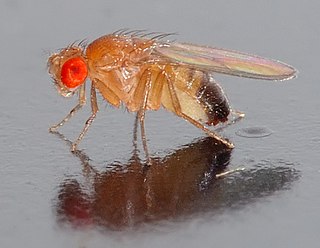
The Chironomidae comprise a family of nematoceran flies with a global distribution. They are closely related to the Ceratopogonidae, Simuliidae, and Thaumaleidae. Many species superficially resemble mosquitoes, but they lack the wing scales and elongated mouthparts of the Culicidae.

The paraphyletic subgenus Sophophora of the genus Drosophila was first described by Alfred Sturtevant in 1939. It contains the best-known drosophilid species, Drosophila melanogaster. Sophophora translates as carrier (phora) of wisdom (sophos). The subgenus is paraphyletic because the genus Lordiphosa and the species Hirtodrosophila duncani are also placed within this subgenus.
Antillocladius is a genus of midges belonging to the family Chironomidae, subfamily Orthocladiinae. The name Antillocladius means orthoclad that occurs in the Antilles, where it was primarily recorded.
Qiniella is a genus of non-biting midges in the diptera subfamily Orthocladiinae of the family Chironomidae.

The genus Axarus is widely distributed with records from the Holarctic, the Neotropics and Australasia . There are currently 5 described nearctic species . Erected as a subgenus (Anceus) of Xenochironomus , Axarus was subsequently renamed and elevated to generic status . The Connecticut River in the eastern United States harbors locally dense populations of two Axarus species, both currently undescribed. These populations are interesting in that they are restricted to specific larval habitat and thus there is genetic structure between populations in the river . The Connecticut River species are also notable in that they have extremely well developed polytene chromosomes and also maintain a high degree of inversion polymorphism .
Apometriocnemus is a genus of non-biting midges in the subfamily Chironominae of the bloodworm family Chironomidae.
Apedilum is a genus of non-biting midges of the bloodworm family Chironomidae. The genus was previously considered a junior synonym of Paralauterborniella, but was restored as a separate genus by J. H. Epler (1988) for the species A. elachistus and A. subcinctum.
Gymnometriocnemus is a genus of non-biting midges in the subfamily Orthocladiinae of the bloodworm family (Chironomidae). The genus is divided into two subgenera, Raphidocladius Sæther 1983 and Gymnometriocnemus Goetghebuer, 1932. Males of the former subgenus are characterized by possessing an extremely long virga with needle-like sclerotization, species of the later characterized by a short virga and a weakly developed crista dorsalis in the adult male hypopygium.

Metriocnemus is a genus of non-biting midges in the subfamily Orthocladiinae of the bloodworm family Chironomidae.

Chironominae is a subfamily of midges in the non-biting midge family (Chironomidae).

Chironomini is a tribe of midges in the non-biting midge family (Chironomidae).

Polypedilum is a genus of non-biting midges in the subfamily Chironominae of the bloodworm family Chironomidae. This is probably the most species-rich of all chironomid genera. Larvae of Polypedilum may also be among the most abundant invertebrates in euthrophic ponds, reaching densities of up to 1200 larvae per square meter.
Beardius is a genus of Pan-American non-biting midges in the subfamily Chironominae of the bloodworm family Chironomidae. It is named after the late Melvin Beard, a student at Eastern New Mexico University.
Buchonomyia is the only extant genus of the subfamily Buchonomyiinae of the non-biting midge family Chironomidae. There are three known extant species and one fossil species in the genus: Members of the genus are parasitic of psychomyiid caddisflies.
Diamesini is a tribe of midges in the non-biting midge family (Chironomidae).
Diamesa is a genus of non-biting midges in the subfamily Diamesinae of the bloodworm family Chironomidae.

Ole Anton Sæther was a Norwegian entomologist.
Limnophyes er is a species of chironomid midge found in Scandinavia and European Russia. This is a distinctive species, both sexes are very dark in colour, the body appearing almost black with darkened wings. The specific epithet er means 'hedgehog' in Latin and refers to the notable setae on the body.

Pontomyia is a genus of flightless marine midges belonging to the subfamily Chironominae in the Chironomidae family. Insects in marine environments are extremely rare while flightlessness, extreme sexual dimorphism, and an extremely short adult life span contribute to making these midges unusual among insects. They are known from the shores of islands in the Indian, Atlantic and Pacific Oceans.






